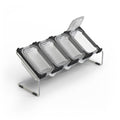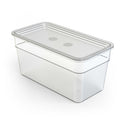WOOD OR PLASTIC?
A SHORT STATEMENT ON HYGIENE.
INTRODUCTION
One often hears that wood is the far more beautiful material, but plastic has a leading edge in terms of hygiene.
After two years of intensive work on the subject, we are beginning to have an urgent suspicion: this discussion is based on a comprehensible, but nonetheless dramatic misunderstanding, and we think it is time to take a clear position.
NO TOLERANCE IN GASTRONOMY - THEREFORE UNHYGIENIC?
The fact that the professionals work exclusively with plastic boards is something that has become known to amateur chefs and has been interpreted to mean that plastic is more hygienic.
This is an obvious assumption, as chefs surveyed on this subject are likely to cite this as the reason for the exclusive use of plastic boards, but without the critical restriction: more hygienic - in the context of a professional kitchen.
And that's the crux of the matter in this debate:
What is justifiably valid in the context of a professional kitchen cannot be transferred to private households without restrictions. On the contrary, if you look at the facts in detail.
THE PLASTICS ORDINANCE - IT' S BETTER TO BE ON THE SAFE SIDE.
To get straight to the point - the whole discussion has its origins in the regulations of the health authorities for professional kitchens:
Those who produce food for other people on a commercial basis have a high responsibility for the well-being of their guests and must make every effort to ensure that the food is in a perfectly hygienic condition - a completely comprehensible demand.
For this reason, manual rinsing - i. e. washing by hand, with the help of a sponge and detergent - has been generally prohibited for some years now, with a few exceptions, and the following applies:
All equipment that comes into direct contact with foodstuffs (particularly critical: raw meat) must be cleaned in the dishwasher, because only at a constant temperature of more than 65° C can pathogens be killed reliably and reproducibly and the tools at least on the surface are thoroughly hygienic and clean.
This is especially true for cutting boards:
Where sharp blades are used, depending on the pressure and degree of sharpness, more or less deep cut furrows are created in the cutting board, regardless of whether it is wood or plastic. With each cut, the blade transports fibres and particles of the cuttings, which get stuck in the cut furrows and thus create optimal living conditions for bacteria and potential pathogens. Possible cross-contamination with other foodstuffs poses a real threat to the health of several people.
Wooden chopping boards are basically not suitable for the dishwasher: The combination of heat and aggressive cleaners causes the wood to become dry and brittle, the glue connections loosen and even solid wooden boards curl up after just a few rinses and are therefore only of limited use.
This reveals a very relevant difference between plastic and wood:
Plastic can and must be cleaned in the dishwasher.
Wood can not be cleaned in the dishwasher, but it also does not need to.
BECAUSE: WOOD IS ACTIVELY ANTIBACTERIAL.
Bacteria that enter the wood via the knife blade are actively neutralized - by tannic acids contained in the wood and released with each new cut - which render the wood germ-free within a few hours. In addition, it is assumed that the porous and hygroscopic wood deprives bacteria of the moisture they need to live.
Plastic boards do not have these tannic acids: Bacteria and fungi can spread there undisturbed to a large extent and find an ideal breeding ground in the food remains, which also end up in the cut furrows.
Plastic is in addition (in contrast to the rather brittle wood) an elastic material, occuring cutting furrows close behind the knife blade again and trap bacteria, moisture and food residues and prevent thereby that cleaning agents and sterilizing heat come where they are needed - thus the dishwasher works 100% reliably actually only on the surface.
Thus, a more differentiated picture of the situation slowly emerges: Bacteria survive considerably longer on plastic boards, the dishwasher does not really reach the actually critical areas and mould forms in the cut furrows.
After a thorough cleaning with hot soapy water and a potting sponge by hand, the wooden boards are almost completely germ-free after a few hours - and remain so for many years.
BAN OF WOOD IN THE GASTRONOMY NEVERTHELESS QUITE REASONABLE
The above results are, of course, contradictory when looking at the common practice in the professional catering trade for the first time: If plastic is actually less suitable as a material for chopping boards, and there are actually more germs on plastic boards - why is wood forbidden instead of plastic?
Here too, of course, the context is decisive. In the hectic everyday life of professional cuisine, different rules apply than in the contemplative everyday kitchen at home.
While the amateur chef scrubs his board conscientiously after cooking and regularly oils it, professional kitchens have to struggle with frequently changing staff. In addition, it is usually unskilled temporary helpers who only do the bone job in the scullery on a temporary basis and who are only rudimentary familiar with the current hygienic regulations.
And that's why the ban on plastics makes sense in professional kitchens: although plastic boards are not perfect, they can still be cleaned in the dishwasher and thus offer a safe process with low error susceptibility and repeatable satisfactory results.
Wooden boards have to be washed by hand as described above and thus offer a high potential for varying results.
CONCLUSION: FINALLY TIME FOR DELIMITATION
Cutting board in private households - PRO WOOD:
1. wood is a natural material.
It is ecologically and non-hazardous on health, looks beautiful, smells pleasant and feels good.
2. Wood can be kept clean and hygienic for years without any problems with some background knowledge and a routine developed from it. There are increasing numbers of studies which, for the above-mentioned reasons, advocate at least equal treatment of wood in the hygienic assessment of plastics in food processing.
(http://www.enius.de/presse/972.html).
(Of course, not every type of wood is equally antibacterially effective - walnut, oak and pine are - due to their high tannic acid content - one step ahead.)
3. Plastic cutting boards are usually too small to work on them properly. Since plastic cutting boards have to be put into the dishwasher in order to be hygienically justifiable, they also have to fit into the dishwashers. Dishwashers for private households (in contrast to professional appliances) are standardised for installation in a standard fitted kitchen, and therefore are too small to store and clean a reasonably sized cutting board.
Cutting board in the private household - PRO PLASTIC:
1. Raw meat and raw fish may be contaminated with pathogens.
It is therefore advisable to process these foodstuffs on smaller, rather thin plastic boards and to put them into the dishwasher afterwards.
2. Aroma separation:
Garlic, onions and chili are known to have a very strong flavour, which can easily be found on other foodstuffs if the working areas are not 100% clearly defined. Again, it is advisable to use said plastic board as a separate work area, which can be cleaned in the dishwasher after the work is done. Alternatively, you can cut more sensitive foods such as fruit on a separate board.
Cutting board in a domestic environment - WHATS THE BEST THING TO DO NOW???
Our very, very personal recommendation:
The best way to do this is to work on a nice large wooden working board, that offers sufficient working and storage space even for radish or Chinese cabbage.
On this board, all vegetables can be prepared without hesitation.
Cleaning and care by hand.
If necessary, small plastic boards can be placed on top of it for meats and fish.
You should be accustomed to having several separate plastic planks readily available and to using them in a disciplined manner.
Also for food with rather strong (garlic) or more sensitive flavours (fruit) it is worthwhile to separate the working areas and thus keep the flavours separate from each other.
Cleaning in the machine.
You can taste a disciplined, clean and precise working routine!























